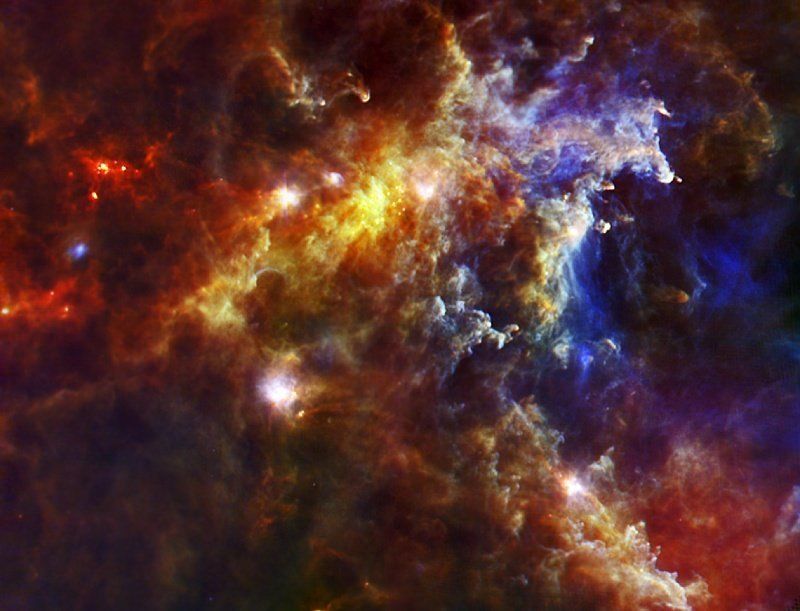
Scientists have spotted swirling patterns in the radiation lingering from the big bang, the so-called cosmic microwave background (CMB). The observation itself isn't Earth-shaking, as researchers know that these particular swirls or "B-modes" originated in conventional astrophysics, but the result suggests that scientists are closing in on a much bigger prize: B-modes spawned by gravity waves that rippled through the infant universe. That observation would give them a direct peek into the cosmos' first fraction of a second and possibly shed light on how it all began.
"I see it as a big step forward," says Charles Bennett, a cosmologist at Johns Hopkins University in Baltimore, Maryland, who was not involved in the work. "I take it as a hopeful sign that we can get to the gravitational-wave signal."
Since it was discovered in 1965, the CMB has proved a font of information for cosmologists. In 1992, NASA Cosmic Background Explorer (COBE) probe measured the spectrum of the radiation, which has cooled as the universe expanded, and found that it had the characteristics that one would expect if the universe had been born in a single burst. COBE also detected part-in-100,000 variations in the temperature of the CMB across the sky, which would reveal much about the cosmos.
By 2003, NASA's Wilkinson Microwave Anisotropy Probe (WMAP) and other experiments had studied those variations statistically and found that they fit a model in which the universe consists of 5% ordinary matter, 24% mysterious dark matter whose gravity binds the galaxies, and 71% bizarre space-stretching dark energy. That standard cosmological model was strongly confirmed earlier this year by the European Space Agency's (ESA's) Planck space probe.
But the CMB may have more information in store. According to the standard cosmology, the temperature variations reflect tiny quantum fluctuations in the newborn universe. These fluctuations were blown up to immense size in the first fraction of a second when the universe doubled and redoubled its size 60 times over in a faster-than-light growth spurt known as inflation. Drawn by gravity, dark and ordinary matter then settled into the fluctuations, seeding galaxies. Inflation may also have left its imprint on the CMB.
The microwaves in the CMB can be polarized like light reflected from the surface of a lake. In a patch of sky, the random polarization pattern can be separated into two superimposed components: B-modes, in which the polarization forms right- or left-handed swirls, and E-modes, in which it does not. Whereas the coalescing of matter in the early universe can produce only E-modes, gravity waves rippling along during inflation should produce B-modes. The intensity of those "primordial" B-modes should reveal the energy density of the universe during inflation and help explain how it happened.
But first scientists must detect B-modes of any kind. That's what the team with the South Pole Telescope (SPT), a 10-meter dish in Antarctica, has done. B-modes can come from "foreground" radiation from within our galaxy, or when the gravity from the vast web of matter that fills the universe distorts the image of E-modes in the CMB. That distortion is called gravitation lensing, and SPT has observed lensing-induced B-modes, says Duncan Hanson, an astrophysicist at McGill University in Montreal, Canada, and lead author on the paper describing the work, which was posted on 22 July to the arXiv preprint server.
Hanson and colleagues began with an external input, a measurement of cosmic infrared radiation from ESA's Herschel space telescope to estimate the distribution of mass in the universe. They then calculated its effect on SPT's own map of the E-modes in a particular patch of sky to predict the lensing-induced B-modes on scales stretching less than a degree. Using this template, they were able tease out B-modes in the data itself. That signal is only 1/100th as strong as the temperature variations. It should be possible to spot the lensing B-modes using only the CMB data, Hanson says, but "we were trying to be very conservative for this first detection, so we chose the analysis with the least sensitivity to instrumental effects."
The observation itself could be very useful, says David Spergel, a cosmologist at Princeton University. Lensing of the images of far-flung galaxies or of the temperature variations in the CMB already provides a probe of distribution of matter in the universe. But lensing of the polarization of CMB should be an even cleaner probe of that distribution, he says.
The result also suggests that scientists may be closing in on B-modes from gravity waves, too. One way to do that would be to subtract the lensing-induced signal to see if there is any signal left over. A more promising tack may be to look for swirls on larger scales, on which the lensing signal should be weaker, Spergel says. A half-dozen ground- and balloon-based experiments are racing to do that, and the new result suggests that they may beat Planck to that goal. "I know from talking to people on the Planck team that they're pushing very hard on this," Spergel says. "They hear footsteps."
Planck isn't designed to hunt for B-modes so it may be a long shot to make that discovery anyway, Bennett says. Moreover, he notes, theory does not predict how strong the primordial B-modes should be: "We really don't know how small the inflationary signal is, so we may not be able to get there from here." Still, Bennett says, the signal could be far stronger than expected—in which case it could show up in a few months when Planck releases more data.
ScienceNOW, the daily online news service of the journal Science
